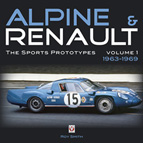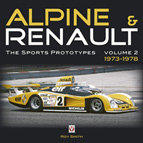Alpine & Renault – The Sports Prototypes Volumes 1 and 2
by Roy Smith, Veloce Publishing, 2010

Volume 1: 1963–1969
208 pages,
300 color & b/w illustrations
$69.95/£34.99
ISBN-13: 978-1-84584-191-1
Order here
 Volume 2: 1973–1978
Volume 2: 1973–1978
224 pages, 359 color & b/w illustrations
$69.95/£34.99
ISBN-13: 978-1-84584-226-0
Order here
Review by Sabu Advani www.Speedreaders.info
Following his previous book Alpine & Renault: The Development of the Revolutionary Turbo F1 Car 1968–1979, Smith takes a look at a very different animal by the same maker/s in this two-volume set: the Sports Prototypes from 1963–1978. Good-looking, reliable, beloved by the French, successful even, but compared to other cars of the time not a great deal has been written about these Alpines, certainly not in book form and most certainly not in English.
Moreover, the full chassis and race history of the M63, M63B, M64, M65, A210, A211, A220, and A221 sports prototypes had never been recorded completely in any language. This, aside from Smith’s personal decades-old interest in these models and in motorsports in general, is a primary reason why he took it upon himself to put pen to paper after having retired from a professional life in sales and marketing. (Read about Roy Smith)
Although no stranger to the subject—having written magazine articles about Alpine Renaults since 1989 and being the UK correspondent for the French magazines Rétro Passion and Mille Miles—Smith finds himself saying: “I never really wanted to be a detective!” Famous last words . . . and in this book the very first words in the author’s Introduction. He went about his sleuthing the right way, by seeking out and personally interviewing a good number of the now 70- and 80-year-old former company and racing team members as well as people associated with the Alpine program such as ex-Lotus chassis designer Len Terry. And no fewer than nine people wrote individual Forewords, all praising this three-year research effort and its contribution to motorsports history. The result is a 150,000-word in-depth treatment that examines the pre-history (i.e. the brothers Renault, and father and son Rédélé who founded Alpine) and the Alpine models’ development, testing, specs, and competition history in Europe, the Americas, and the Far East. It covers every chassis and nearly every driver. There is a natural breaking point between the two books; volume 1 ends with Renault withdrawing from sports prototype racing in 1969 and volume 2 picks up the thread four eventful years later during which Renault had taken a majority stake in Alpine (they didn’t fully absorb it until 1977), totally reconfigured the cars to conform to the drastically changing sporting regs, and embarked on a failure-not-acceptable mission to score an overall win at Le Mans. So, while each volume covers a distinct period and stands on its own, the only way to get the full picture is to have both. What is not covered in great depth are the Alpine road going sports cars, from the A106 to the A110. The title reads “The Sports Prototypes” and that is to be taken literally.
The first four pages of Chapter Six Volume 2 can be read on a pdf.
As the Alpine Renault team approaches the year 1978, Smith takes us through the ongoing development of oil and tires which would bring to Alpine the “greatest racing achievement in the reliatively short history of the marque…” Read pdf here.
Incidentally, one name is integral to this story, especially the first part: Amédée Gordini, racecar driver and sports car manufacturer who among many other things supplied engines to Alpine. He will be the subject of Smith’s next book, due late 2011. Women in racing are rare enough, certainly back then, and female readers/racers especially will appreciate photos and text about Lella Lombardi and Marie-Claude Beaumont.
Please take the time to contribute and keep VeloceToday coming to your inbox every week. It’s easy and safe. Simply click here for details.